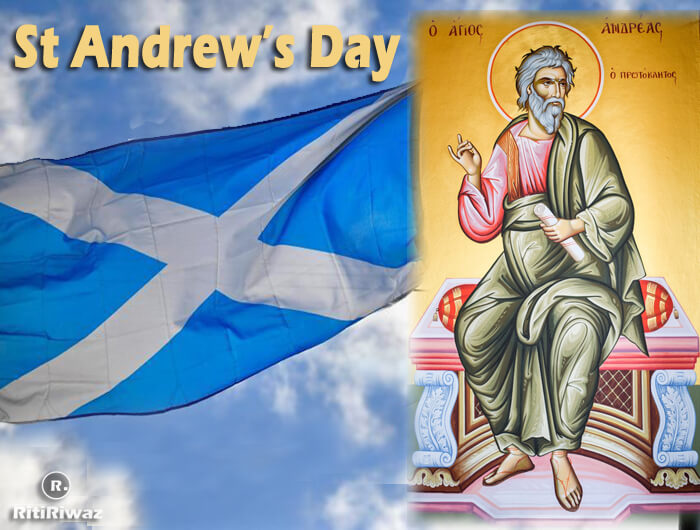St Andrew’s Day

St Andrew’s Day is celebrated on November 30 and is the national day of Scotland. St. Andrew along with his brother Simon Peter were fishermen and disciples of Jesus Christ. He was crucified by the Romans and legend has it that Andrew’s relics were taken to Fife, Scotland in the eighth century for safekeeping.
While St. Andrew’s Day is more commonly associated with Scotland, Saint Andrew himself is the patron saint of several countries, including Greece, Romania, Russia, Poland, and Ukraine, plus more!
History
St Andrew has been celebrated in Scotland for over a thousand years, with feasts being held in his honor as far back as the year 1000 AD. However, it was in 1320, when Scotland’s independence was declared with the signing of The Declaration of Arbroath, that he officially became Scotland’s patron saint. Since then St Andrew has become tied up in so much of Scotland. The flag of Scotland, the St. Andrew’s Cross was chosen in honor of him. Also, the ancient town of St Andrew’s Cross was named due to its claim of being the final resting place of St Andrew.
St Andrew was born in Galilee, now part of Israel. He was a fisherman and one of Christ’s disciples. He was a kind and generous man, his philosophy was to share whatever you had with those less fortunate. He was crucified by the Romans after Jesus’ death. Legend says that a Greek monk was ordered to take relics of Saint Andrew to “the ends of the earth” for safekeeping, and landed on the coast of Fife, which is now known as St. Andrews.
The Saltire cross of St Andrew dates back to the earliest days of the emerging nation of Scotland. During the reign of King Angus of the Picts, from 820 to 834, legend has it that the king saw the cross in a dream the night before a battle with the Saxons. The following morning, he was filled with confidence that his men could defeat the Saxons in the name of St Andrew, and since this time he and his Saltire Cross have become national symbols for the country.
Suggested Read: Christian Festival
Scotland and St Andrew’s Day
In Scotland, and many other countries that have Scottish associations, St. Andrew’s day is marked with a celebration of Scottish culture and traditional Scottish food, music, and dance. You’ll often find schools across the country holding special St. Andrew’s Day events and activities, varying from art shows, Scottish country dancing, dance festivals, storytelling, poetry, bagpipe-playing, and much more.
Today, St Andrew’s Day is a national holiday that celebrates the hallmarks of Scottish culture, food, and dance. There are bagpipes, traditional Scottish music, and of course, no shortage of people dressed in traditional Scottish dress. To simply describe tartan fabrics as ‘traditional’ is indeed true, but does them something of a disservice; to the Scottish people, they’re far more than that.
Tartan is recognized as a Scottish symbol the world over, and few other fabrics can claim to have such a deep and diverse range of meanings. The pattern’s many variations are symbolic of the many different clans that have historically made up the Scottish people, making each tartan pattern a point of pride for Scottish people in both their unique familial history and united national heritage.
Suggested Read: First Sunday of Advent
